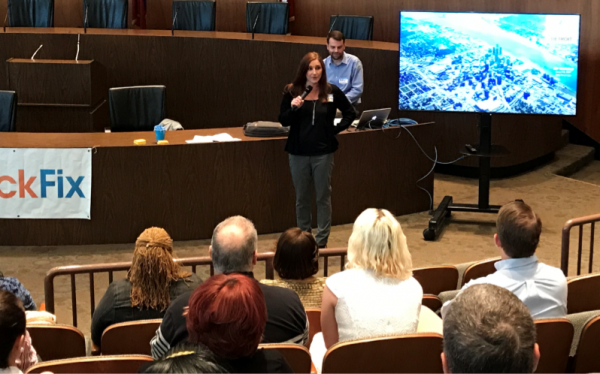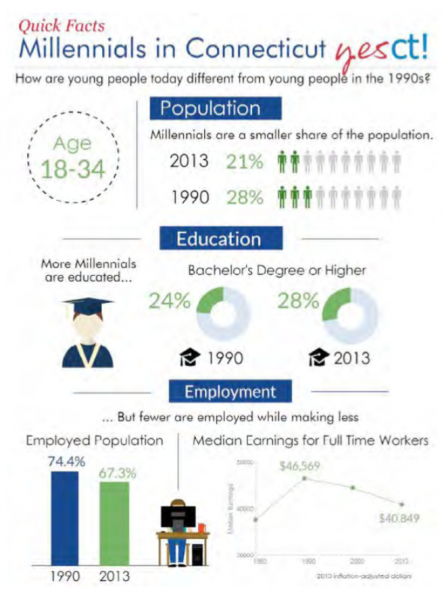PERSPECTIVE: How Connecticut Businesses Are Doing More For People With Autism
/by Lucy Wyndham Even as the number of children with special needs increases in Connecticut schools, businesses are creating sensory-friendly environments to accommodate the growing population of children and adults with Autism Spectrum Disorder (ASD). In fact, while there are examples in Europe, the UK, and Australia of retail centers working to accommodate their ASD customers better, small businesses in Connecticut might just be leading the way in the United States.
What Do Sensory Issues Have to Do With Autism?
Autism is a mental condition present from early childhood. Children and adults with autism are characterized by difficulty in forming relationships with other people due to difficulty in grasping social skills, and difficulties in using language and abstract concepts.
Sensory issues are especially prevalent for ASD individuals, as they likely have issues processing information take in through the senses. Where a fluorescent light in a store might not even be noticed by a typical person, a person with autism might find the light physically painful, and might respond in ways that seem aggressive or violent.
Can Autism Help Us?
Growing research indicates that neurodiversity, i.e. the idea that neurological differences like autism are the result of normal variations in the human genome, might actually be a competitive advantage. However, even as the number of children with autism increases, people on the spectrum are largely considered unemployable.
Companies like EY, which created a pilot program to bring new hires with Asperger’s, and airports across the globe that are creating quiet rooms in for children with sensory issues, are at the tip of the spear of a new movement to capture ASD customers and increase ASD hires. Connecticut firms are not far behind.
Sensory Friendly Accommodations
The Connecticut Science Center in Hartford provides over 150 hands-on exhibits for young people, as well as a state-of-the-art 3D digital theater and four education labs. However, for young people struggling with sensory overload, the bustling sounds and bright lights make it nearly impossible to navigate for families with autistic children.
The Science Center has created special Sensory Friendly Hours in the past, and now has a Sensory Friendly Day planned. Visitors with special needs can enjoy a special sensory-friendly theater presentation, lowered PA volume, and dimmed lights for the hours of the event. What’s especially attractive to families about events like these is the lack of stigma. Families know they’ll be entering an environment that understands and cares, and is truly a judgment-free zone.
Even theaters are beginning to provide sensory-friendly film experiences for families. Last summer, select AMC theaters hosted special film viewings with the lights up, the sound turned down, and an open invitation for audience members to move around, be active, and make noise. The program was jump started with a parent request, and over 300 children and parents attended the first screening.
It’s a Great Start
Making conducive physical accommodations available for those with autism is helpful and popular with children on the spectrum, but businesses don’t have to stop there. One of the most valuable things a company can do is educate staff and employees on autism, enabling staff to be resources in a supportive environment for children and adults.
Also, businesses can:
- Change how they hire (moving away from interview-based hiring practices to low key, informal tasks and projects)
- Offer more online experiences so ASD individuals don’t have to go into the store
- Dim the lights, and make more use of natural light
- Create quiet rooms or break away spaces
- Provide noise canceling headphones and fidget spinners
- Lower the noise
Autism impacts over 1% of the worldwide population, but with nearly 1 in 3 young adults on the spectrum disconnected from work and school, businesses must do more to accommodate for the neurological differences autism causes. Special hours and program just for customers with sensory processing issues are a great start, but most Connecticut firms continue to strive to do more to hire ASD staff and to accommodate ASD customers.
_____________________________
Lucy Wyndham is married to a guy on the autism spectrum. It's a wonderful and interesting ride, which has opened up her eyes to a new way of seeing the world. She is also a writer, content manager, and a mother to two wonderful daughters.





 “Despite growing private-sector demand, it appears that construction employment in some parts of the country is being brought down by declining public-sector investments,” said Ken Simonson, chief economist for the association. “Some of these declines will be offset thanks to recently enacted state infrastructure funding increases, but stagnant federal investments are not helping.”
“Despite growing private-sector demand, it appears that construction employment in some parts of the country is being brought down by declining public-sector investments,” said Ken Simonson, chief economist for the association. “Some of these declines will be offset thanks to recently enacted state infrastructure funding increases, but stagnant federal investments are not helping.” e of new construction jobs during the past year, followed by Nevada (12.8 percent, 9,700 jobs).
e of new construction jobs during the past year, followed by Nevada (12.8 percent, 9,700 jobs).
 his 12 year old son and a friend play a game in their backyard in Fairfield, using a perforated plastic golf ball and a broomstick handle. They had given up on baseball and softball – not enough players for two teams, not enough space for a field, and too many broken windows.
his 12 year old son and a friend play a game in their backyard in Fairfield, using a perforated plastic golf ball and a broomstick handle. They had given up on baseball and softball – not enough players for two teams, not enough space for a field, and too many broken windows. The National Toy Hall of Fame receives thousands of nominations annually. Whiffle Ball was nominated, but not selected, in 2015. The final 2017 toy inductees, chosen on the advice of a national selection advisory committee, will be announced at The Strong museum on Thursday, November 9. Only two or three of these finalists will join other iconic toys in the hall and sit alongside past inductees such as Barbie, LEGO, Monopoly, Rubik’s Cube, and Star Wars action figures.
The National Toy Hall of Fame receives thousands of nominations annually. Whiffle Ball was nominated, but not selected, in 2015. The final 2017 toy inductees, chosen on the advice of a national selection advisory committee, will be announced at The Strong museum on Thursday, November 9. Only two or three of these finalists will join other iconic toys in the hall and sit alongside past inductees such as Barbie, LEGO, Monopoly, Rubik’s Cube, and Star Wars action figures. The Strong’s National Toy Hall of Fame recognizes toys that have engaged and delighted multiple generations, inspiring them to learn, create, and discover through play. Criteria for induction include: Icon-status (the toy is widely recognized, respected, and remembered); Longevity (the toy is more than a passing fad and has enjoyed popularity over multiple generations); Discovery (the toy fosters learning, creativity, or discovery through play); and Innovation (the toy profoundly changed play or toy design).
The Strong’s National Toy Hall of Fame recognizes toys that have engaged and delighted multiple generations, inspiring them to learn, create, and discover through play. Criteria for induction include: Icon-status (the toy is widely recognized, respected, and remembered); Longevity (the toy is more than a passing fad and has enjoyed popularity over multiple generations); Discovery (the toy fosters learning, creativity, or discovery through play); and Innovation (the toy profoundly changed play or toy design).
 broken meters and streetlights, potholes, and even excessive noise from ice-cream trucks). Officials can track, manage and reply within the app. It has since expanded to some 300 municipalities across the country.”
broken meters and streetlights, potholes, and even excessive noise from ice-cream trucks). Officials can track, manage and reply within the app. It has since expanded to some 300 municipalities across the country.” Hurricane Harvey, the efforts with Houston instantly intensified. Berkowitz said SeeClickFix has worked with the city of Houston and several of its neighboring suburbs since 2009, handling an estimated 30,000 residents. Those numbers will likely jump when the totals for 2017 are tallied. Berkowitz told CTNewsJunkie that will be especially true in the coming weeks as operations shift from emergency calls handled by police and other emergency personnel to calls that are SeeClickFix specialties, such as power outages, downed trees and other types of “more routine” assistance.
Hurricane Harvey, the efforts with Houston instantly intensified. Berkowitz said SeeClickFix has worked with the city of Houston and several of its neighboring suburbs since 2009, handling an estimated 30,000 residents. Those numbers will likely jump when the totals for 2017 are tallied. Berkowitz told CTNewsJunkie that will be especially true in the coming weeks as operations shift from emergency calls handled by police and other emergency personnel to calls that are SeeClickFix specialties, such as power outages, downed trees and other types of “more routine” assistance. The company’s website continues to proudly boast “Made in New Haven” and Berkowitz’ company profile explains “The inspiration for SeeClickFix came from a desire to improve his own community with his neighbors and his government.”
The company’s website continues to proudly boast “Made in New Haven” and Berkowitz’ company profile explains “The inspiration for SeeClickFix came from a desire to improve his own community with his neighbors and his government.” from the top down” as the publication highlights “some of the most promising projects, initiatives, and companies that are springing up in every state of the union. Together, they present a portrait of the country today—its concerns and responses, and its enduring capacity for progress.”
from the top down” as the publication highlights “some of the most promising projects, initiatives, and companies that are springing up in every state of the union. Together, they present a portrait of the country today—its concerns and responses, and its enduring capacity for progress.”



 Connecticut’s inability to retain young people has become increasingly evident over the past several years, resulting in dour headlines as major companies pick up stakes and move to those locations that are attracting young talent. An interest in lively downtowns, a variety of housing options, walkable communities, access to transit, and availability of jobs and economic opportunity are topping their lists, according to numerous studies and reports.
Connecticut’s inability to retain young people has become increasingly evident over the past several years, resulting in dour headlines as major companies pick up stakes and move to those locations that are attracting young talent. An interest in lively downtowns, a variety of housing options, walkable communities, access to transit, and availability of jobs and economic opportunity are topping their lists, according to numerous studies and reports.



 Attracting hundreds of women in manufacturing from across the country, WiM's annual Summit is the only national conference of its kind. This networking and educational event features manufacturing plant tours, professional development tracks, industry roundtables, keynote presentations and social events to expand participants' networks.
Attracting hundreds of women in manufacturing from across the country, WiM's annual Summit is the only national conference of its kind. This networking and educational event features manufacturing plant tours, professional development tracks, industry roundtables, keynote presentations and social events to expand participants' networks. any, TRUMPF Inc., and Pratt & Whitney, all on the opening day of the conference on September 13.
any, TRUMPF Inc., and Pratt & Whitney, all on the opening day of the conference on September 13. Engineers, and George Saiz, President & CEO of The Association for Manufacturing Excellence.
Engineers, and George Saiz, President & CEO of The Association for Manufacturing Excellence. Among the host committee members is the Connecticut Business and Industry Association. The New Haven Manufacturers Association and the Waterbury Regional Chamber’s Manufacturer’s Council are among the Supporting Partners for the Summit.
Among the host committee members is the Connecticut Business and Industry Association. The New Haven Manufacturers Association and the Waterbury Regional Chamber’s Manufacturer’s Council are among the Supporting Partners for the Summit.

























